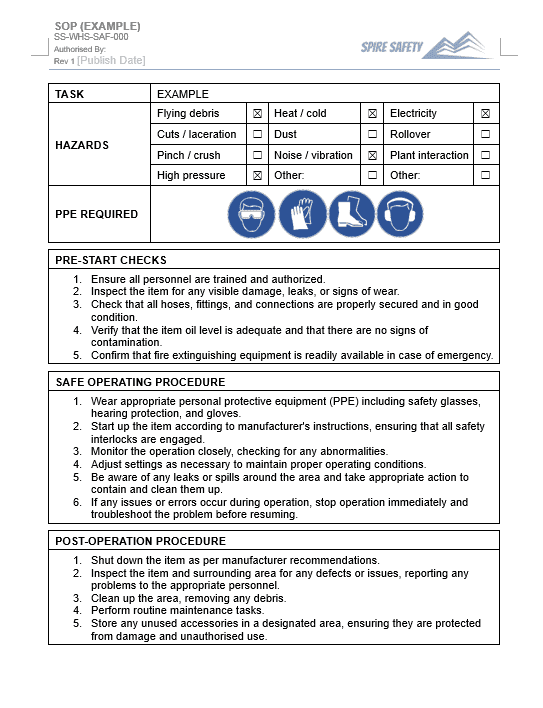Free 3D Printer SOP (Safe Operating Procedure) Template
Download our free 3D Printer SOP Template:
*For internal use only. Not for resale or redistribution. By downloading, you agree to our Free Resources Licensing Agreement.

Purpose of Document
3D Printer SOPs outline a safe operating procedure for 3D printer use. SOPs can also be used as a training and induction document. The primary goal is to protect workers from injury or illness by outlining a safe system of work and providing adequate training and instruction. This form is broadly aligned with AS45001:2018.
How to Use
This 3D Printer SOP should be communicated to workers before they complete the task. A hard copy can also be displayed in the workplace or provided at the workface. You can also use this document during the induction or onboarding process.
NOTE: This document is a template only and it must be customised for your business. Other aspects that need to be considered include, but are not limited to, ensuring that:
- Relevant legal requirements have been met,
- Workplace specific risks are identified and managed, and
- Workers are consulted with during the customisation / review process.
When to Use
Workers should read and agree to comply with 3D Printer SOPs prior to operation within your business. They can also be used for refresher training periodically.
Who Should Use
3D Printer SOPs should be developed by a competent person. The SOP is then read and followed by the worker completing the task. New workers should also read and understand the SOPs during the induction or onboarding process.
Legal Considerations
There is no specific legal requirement to have a documented Safe Operating Procedure (SOP). However, it is best practice, as having SOPs can assist in meeting general legal duties, including:
- s(19)(3)c WHS Act – Duty to Provide Safe Systems of Work
- s(19)(3)d WHS Act – Duty to Ensure Safe Use of Plant
- s(19)(3)f WHS Act – Duty to Provide Adequate Information, Training, Instruction and Supervision
- s(39) WHS Regulations – Duty to Provide Adequate Information, Training, and Instruction
- s(203) WHS Regulations – Management of Risks to Health and Safety (PCBUs with management or control of plant)
The Code of Practice “Managing risks of plant in the workplace” states that employers (PCBUs) must provide workers with information, training, and instruction as necessary to protect them from risks arising from the use of the plant.
FAQ
What is a 3D printer?
A 3D printer is a machine that creates three-dimensional objects by depositing layers of material, such as plastic filament or resin, according to a digital design.
What is a 3D printer used for?
It’s commonly used in various industries including manufacturing, prototyping, healthcare, and education, for producing prototypes, custom parts, medical implants, and architectural models. What hazards are involved in using a 3D printer?
Some hazards that are involved in 3D Printer3D printer use include:
- Exposure to heat
- Fumes
- Burns
- Electric shock
What are some safety controls that can be utilised during 3D printer use?
Some safety controls that can be utilised include:
- Ventilation
- Wearing PPE
- Machine guards
- Operator training
Did you know?
The 3D printer, a transformative technology in manufacturing and design, has a captivating history reshaping industries worldwide. Invented in the 1980s by Chuck Hull, the first 3D printer utilized a process called stereolithography to create 3D objects layer by layer from digital designs. This breakthrough revolutionized prototyping and rapid manufacturing, allowing for faster and more cost-effective production of complex parts and prototypes. Since then, 3D printing technology has advanced rapidly, with various techniques such as Fused Deposition Modeling (FDM) and Selective Laser Sintering (SLS) emerging. Today, 3D printers are employed in diverse fields including aerospace, healthcare, automotive, and consumer goods, enabling innovation and customization on unprecedented scales.
Article Sources and Further Reading
- Model Code of Practice: Managing risks of plant in the workplace (Safe Work Australia) <https://www.safeworkaustralia.gov.au/doc/model-code-practice-managing-risks-plant-workplace>
- Plant (Safe Work Australia) <https://www.safeworkaustralia.gov.au/safety-topic/managing-health-and-safety/plant>
- The Complete Guide to WHS Policies and Procedures in Australia (Spire Safety) <https://spiresafety.com.au/resources/guide-to-whs-policies-and-procedures/>
- What is a PCBU? (Spire Safety) <https://spiresafety.com.au/resources/what-is-a-pcbu/>
